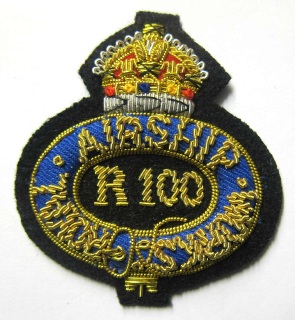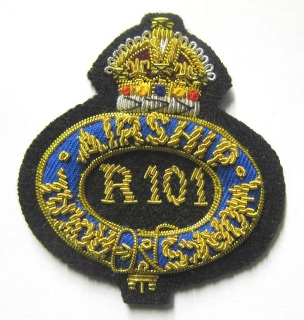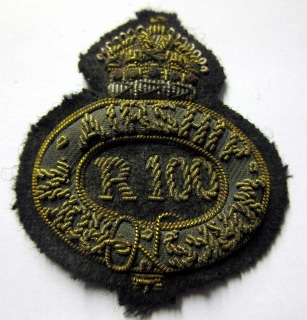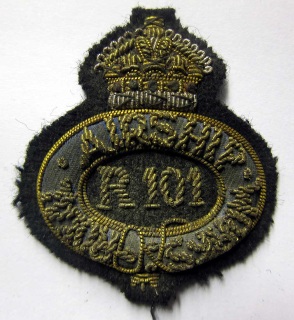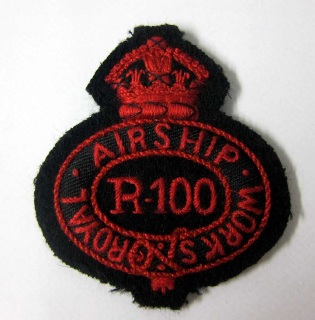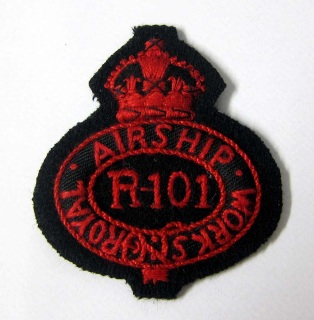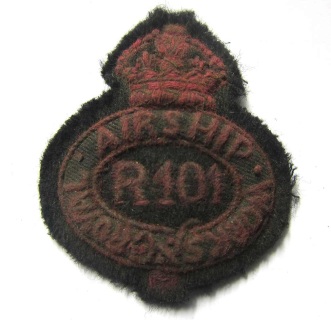Store > Other Periods Hats & Headwear Accessories: >R100 & R101 Airships Crew & Officers Hat Badges:
R100 & R101 Crew Badges Royal Airship Works:
His Majesty's Airship R100, known simply as the R100, was a privately designed and built rigid British airship made as part of a two-ship competition to develop a commercial airship service for use on British Empire routes as part of the Imperial Airship Scheme. The other airship, the R101, was built by the British Air Ministry, but both airships were funded by the Government.
Cardington became one of the major British sites involved in the development of airships when Short Brothers bought land there to build airships for the Admiralty. They constructed a 700-foot-long (210m) airship hangar (the No. 1 Shed), in 1915 to enable them to build two rigid airships, the R-31 and the R-32. Some 800 people worked there in 1917, most of them travelled daily from Bedford. Shorts also built a housing estate, opposite the site, which they named Shortstown.
The airships site was nationalised in April 1919, becoming known as the Royal Airship Works.
In preparation for the R101 project the No 1 shed was extended between October 1924 and March 1926; its roof was raised by 35 feet and its length increased to 812 feet. The No. 2 shed (Southern shed), which had originally been located at RNAS Pulham, Norfolk, was dismantled in 1928 and re-erected at Cardington.
After the crash of the R101, in October 1930, all work stopped in Britain on airships. Cardington then became a storage station.
The badges below are reproductions of those worn by the Royal Airship Works R100 AND R101 Crews.
Cardington became one of the major British sites involved in the development of airships when Short Brothers bought land there to build airships for the Admiralty. They constructed a 700-foot-long (210m) airship hangar (the No. 1 Shed), in 1915 to enable them to build two rigid airships, the R-31 and the R-32. Some 800 people worked there in 1917, most of them travelled daily from Bedford. Shorts also built a housing estate, opposite the site, which they named Shortstown.
The airships site was nationalised in April 1919, becoming known as the Royal Airship Works.
In preparation for the R101 project the No 1 shed was extended between October 1924 and March 1926; its roof was raised by 35 feet and its length increased to 812 feet. The No. 2 shed (Southern shed), which had originally been located at RNAS Pulham, Norfolk, was dismantled in 1928 and re-erected at Cardington.
After the crash of the R101, in October 1930, all work stopped in Britain on airships. Cardington then became a storage station.
The badges below are reproductions of those worn by the Royal Airship Works R100 AND R101 Crews.
Air Ministry & Vickers Airships crew Badges as worn by R100 & R101 Personnel:
These are reproductions badge based on originals - there were several versions, of the Royal Airship Works cap badge but without doubt these are highly accurate and the worlds best copies.
New R100 Royal Airship Works Officers cap badge #1
New Condition Royal Airship Works Officers Cap Badge. We have based this one on an original - it is the worlds best copy.
New R101 Royal Airship Works Officers cap badge #2
New Condition Royal Airship Works cap badge as worn by the Officers of Airship R101. This one is also based on an original. This is the worlds best copy.
R100 Royal Airship Works Officers cap badge #3 Aged Condition
Aged Condition Royal Airship Works Officers Cap Badge. We have based this one on an original - it is the worlds best copy.
R101 Royal Airship Works Officers cap badge #4 Aged Condition
Aged Condition Royal Airship Works Officers Cap Badge. We have based this one on an original - it is the worlds best copy.
New R100 Royal Airship Works Crew cap badge #5
New Condition Royal Airship Works Crew Cap Badge. We have based this one on an original - it is the worlds best copy without any doubt having consulted several Airship experts.
New R101 Royal Airship Works Crew cap badge #6
New Condition Royal Airship Works Crew Cap Badge for R101 Airship. We have based this one on an original - it is the worlds best copy without any doubt having consulted several Airship experts.
Aged R100 Royal Airship Works Crew cap badge #7
Aged Condition Royal Airship Works Crew Cap Badge. Made from red and black cotton and worn by the Crew (non-officers) of the R100 Airship flown from Cardington near Bedford in the United Kingdom.
The site started life as a private venture when aircraft manufacturing company Short Brothers bought land there to build airships for the Admiralty. The airships site was nationalised in April 1919, becoming known as the Royal Airship Works.
The site started life as a private venture when aircraft manufacturing company Short Brothers bought land there to build airships for the Admiralty. The airships site was nationalised in April 1919, becoming known as the Royal Airship Works.
Aged R101 Royal Airship Works Crew cap badge #8
Aged Condition Royal Airship Works Crew Cap Badge for R101 Airship. We have based this one on an original - it is the worlds best copy without any doubt having consulted several Airship experts. This is not a flat one dimensional badge the text is on a raised padded oval made of cotton. The red cotton is faded and the whole badge is aged.
Royal Airship Works - RAW - Lapel Pin Badge. New Condition
The Cardington airships site was nationalised in April 1919, becoming known as the Royal Airship Works. The RAW built several airships including the R100 and R101.
The first airships to be constructed, the L.31 and L.32, were reproductions of the Schutte Lanz design, Later, R.38 was constructed for special operations in the North Sea, capable of an altitude in excess of enemy aircraft at the time. Before it flew R. 38 was sold to the United States Navy and was called the Z. R. 2.
The Royal Airship Works was disbanded in November 1938 when it was renamed the Balloon Development Establishment.
This Royal Aircraft Works lapel badge is thought to have been worn by all personnel employed by the RAW. It was also used on stationary and most likely other materials.
'PER COELUM AD ANTIPODES' is Latin for the motto 'Through the heavens to the antipodes'. (The antipodes of any place on the Earth is the place that is diametrically opposite it.) Note:- the 'Œ' is correct it is Greek for Diphthong - two adjacent vowel sounds occurring within the same syllable.
This badge is in NEW condition.
The first airships to be constructed, the L.31 and L.32, were reproductions of the Schutte Lanz design, Later, R.38 was constructed for special operations in the North Sea, capable of an altitude in excess of enemy aircraft at the time. Before it flew R. 38 was sold to the United States Navy and was called the Z. R. 2.
The Royal Airship Works was disbanded in November 1938 when it was renamed the Balloon Development Establishment.
This Royal Aircraft Works lapel badge is thought to have been worn by all personnel employed by the RAW. It was also used on stationary and most likely other materials.
'PER COELUM AD ANTIPODES' is Latin for the motto 'Through the heavens to the antipodes'. (The antipodes of any place on the Earth is the place that is diametrically opposite it.) Note:- the 'Œ' is correct it is Greek for Diphthong - two adjacent vowel sounds occurring within the same syllable.
This badge is in NEW condition.
Royal Airship Works - RAW - Lapel Pin Badge. Aged Condition
This extremely rare Royal Aircraft Works pin badge is thought to have been worn by all staff and crews employed by the RAW as well as the Social Club. It was also used on printed stationary and most likely other RAW property.
'PER COELUM AD ANTIPODES' is Latin for the motto 'Through the heavens to the antipodes'. (The antipodes of any place on the Earth is the place that is diametrically opposite it.) Note:- the 'Œ' is correct it is Greek for Diphthong - two adjacent vowel sounds occurring within the same syllable. This badge is in AGED condition, no two will be identical after our hand ageing process.
'PER COELUM AD ANTIPODES' is Latin for the motto 'Through the heavens to the antipodes'. (The antipodes of any place on the Earth is the place that is diametrically opposite it.) Note:- the 'Œ' is correct it is Greek for Diphthong - two adjacent vowel sounds occurring within the same syllable. This badge is in AGED condition, no two will be identical after our hand ageing process.
|
|
